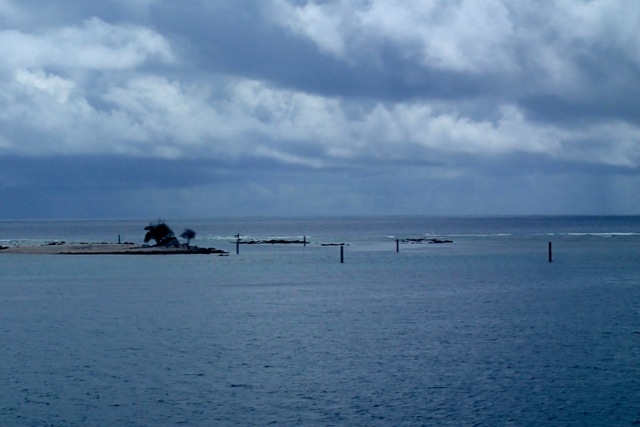navire - 2802 Feb 2017
Nanumea's Last Goodbye DAVID I have to write this piece because it was my fault. There's no way round it. Nanumea still had the unexpected waiting for us, held back for the very last moment of our time there. A day before leaving we tried lifting our anchor. One or two others had had great difficulty with chain wrapped around the many coral heads out of sight below our boats. Sure enough we too could not get free. Sylvan, off the French boat, Menkar, dove to free our chain. He had phenomenal breath holding ability, easily two minutes while doing heavy manual labour twenty metres down. The following day five of the fleet lined up to run through the pass. Free Spirit were first out, holding their breath the whole way through the narrow, shallow channel. Anahata and True Blue V followed and then it was our turn. The tide had turned and was running into the lagoon against us, so I gave her quite a bit of throttle and we picked up speed as Navire slid into the narrow opening. At the outer end of the pass the gap seemed to be widening. We were all but out. I spied a much lighter shade of turquoise indicating a shallower patch and eased Navire just a little to starboard. Almost immediately the channel face loomed up a couple of feet under our starboard bilge and I turned Navire a little to port. At the same time the bottom front of the keel struck hard. Navire heeled forty degrees to starboard amidst the incredibly loud sound of heavy fibre glass tearing on an unyielding coral ridge. Janet who had been standing in the companionway was hurled across the cockpit. Navire's twelve tons was stopped in an instant although the awful grinding noise continued. I took the engine out of gear not wanting to push our home any further onto the reef. We perched there at an alarming angle grinding ever more of our keel to dust and just long enough for the thought "so this is how it ends" to pass through my mind. Navire then slid to port, the mast came upright and we found ourselves bobbing in the channel. I engaged the engine and motored into blessedly deep blue Pacific Ocean. The whole dramatic moment lasted less than a minute, the longest of my life. The VHF radio burst into life. Clara Kathryn and Skua, in the channel a little behind, were concerned for us and alarmed for themselves. Just what had we hit? Would they hit it too? They both exited safely and stopped close to us as I readied to dive under Navire. In the water I fumbled with flippers and mask, my heart still racing, my mind a blur of anxiety, shame and fear. There was a sizable gouge in the bottom, forward edge of the keel and a scar along its full length. Most single hulled yachts have several tons of lead bolted to the bottom of their keel which is in turn is bolted to the hull. An impact such as Navire suffered would have put enormous strain on those critical keel bolts. But Navire has her lead encased in the heavy fibreglass keel which is an integral part of the ship, not a separate attachment. Still I searched for cracks or any other sign of structural damage but could find none. Thankfully the keel was the only part of the boat that made contact with the coral. The rudder and bilges were unscathed. There seemed little sense in retreating to the shelter of Nanumea lagoon. Other than the ugly scar, the boat seemed fine. She was not taking on water. The keel was not about to fall off, nor was the boat about to sink. Tarawa, in Kiribati, less than three days away, was a better bet for hauling Navire if it came to that. For the next few weeks we would be watching for water in the bilge hoping to be reassured that I had not caused damage sufficient to pull our house out of the water. In the mean time we set our sails and headed north. =20

Add new comment